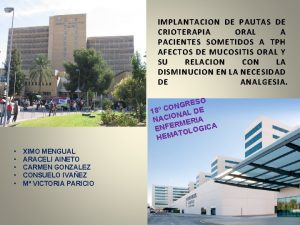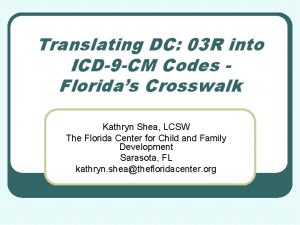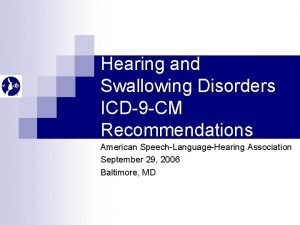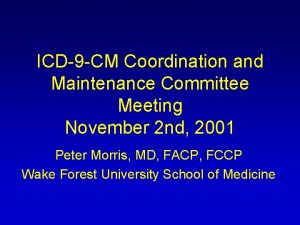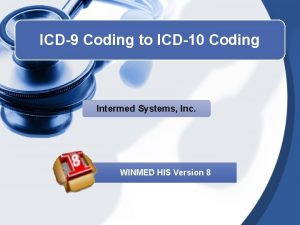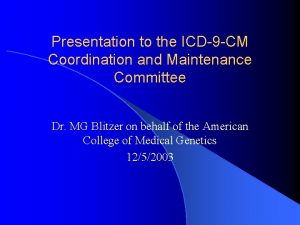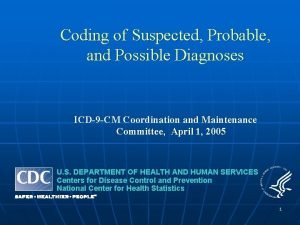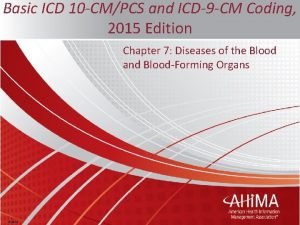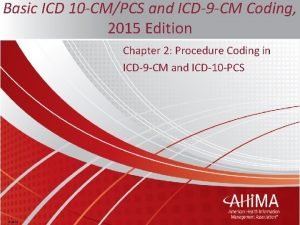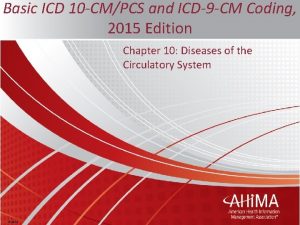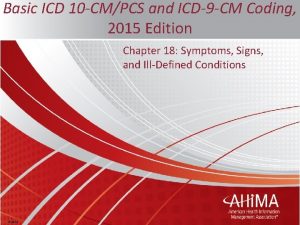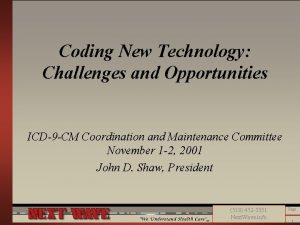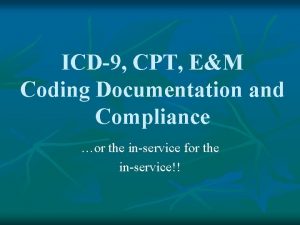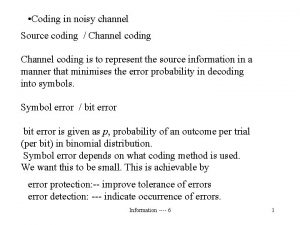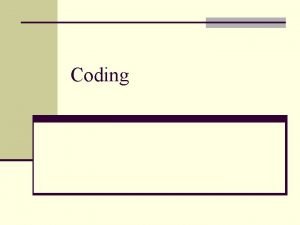Coding for Mucositis ICD9 CM Coordination and Maintenance


















- Slides: 18

Coding for Mucositis ICD-9 -CM Coordination and Maintenance Committee Meeting Patrick J. Stiff, MD Loyola University Medical Center September 30, 2005

What is Mucositis? n Mucositis is inflammation of the mucosal surfaces throughout the body. n It typically involves redness and ulcerative sores in the soft tissues of the mucosa. n Oral mucositis manifests as erythema, inflammation, ulceration, and hemorrhage in the mouth and throat. Image from: Spielberger, Ricardo; Kepivance. TM: A Breakthrough for Oral Mucositis Associated with Myeloablative Hematopoietic Stem Cell Transplantation; City of Hope National Medical Center, Department of Hematology and Bone Marrow Transplantation

Causality n Mucositis is a frequent complication of anticancer treatment, including chemotherapy and radiation therapy. n Due to high-dose chemotherapy and/or radiation preconditioning, it is particularly common in patients preparing for bone marrow transplantation (BMT). Source: Bellm LA, Epstein JB, Rose-Ped A, Martin P, Fuchs HJ. Patient reports of complications of bone marrow transplantation; Support Care Cancer. 2000 Jan; 8(1): 33 -9

Mechanisms n Characterized by damage to the epithelium of the oropharyngeal cavity and GI tract n Rapidly dividing basal cells of the oral mucosa are among the body cells vulnerable to damage by chemotherapy and radiation therapies. * Phases of Mucositis** *National Institutes of Health Symptom Research: http: //symptomresearch. nih. gov/Chapter_17/sec 7/cghs 7 pg 1. htm **Adapted from Sonis. Nat Rev Cancer. 2004; 4: 277 -284.

Sites of Mucositis n While the oral mucosa is the most frequent site of mucosal toxicity, mucositis also is common along the entire alimentary tract: – Esophagus – duodenum – Stomach – ileum/jejunum – colon – rectum n GI mucositis occurs via a mechanism similar to that in the oral mucosa, only the damage to the mucosal layer is more aggressive than in oral mucositis. n Although less common, treatment of ovarian and nasopharyngeal cancer also can result in vaginal and nasal mucositis. Source: http: //symptomresearch. nih. gov/Chapter_17/sec 2/cghs 2 pg 1. htm

Severity Scales n Many validated instruments have been developed to stage and measure mucositis severity. – National Cancer Institute’s Common Toxicity Criteria (NCI CTC) – World Health Organization’s (WHO’s) Oral Toxicity Scale (OTS)

WHO’s Oral Toxicity Scale World Health Organization’s Oral Toxicity Scale Severe Mucositis Grade 1 Grade 2 Grade 3 Grade 4 Soreness ± erythema Erythema, ulcers; patient can swallow solid food Ulcers with extensive erythema; patient cannot swallow food Mucositis to the extent that alimentation is not possible

Epidemiology n 40% of patients receiving standard-dose chemotherapy n 80% of patients receiving radiation therapy for head and neck cancer n 75% of all patients undergoing BMT Mucositis Frequency: Standard-Dose Chemotherapy Source: Bellm et al. 2000 Mucositis Frequency: Radiation for Head and Neck Cancer Mucositis Frequency: BMT with High-Dose Chemotherapy and/or Radiation Pre-Conditioning

Clinical Consequences n Painful condition that interferes significantly with patient functioning and tolerance for cancer therapy n Functional implications may include: – Inability to tolerate food or fluid intake – Difficulty or inability to talk* è In a recent study, BMT patients ranked mucositis as the most debilitating side effect of their treatment. ** *Borbasi S, Cameron K, Quested B, Olver I, To B, Evans E. More than a sore mouth: patients' experience of oral mucositis. Oncol Nurs Forum. 2002; 29: 1051 -1057, and Bellm et al. 2000. **Bellm et al. 2000

Clinical Consequences (continued) n Hospital admission or extended hospitalization for total parenteral nutrition, intravenous analgesia, and intravenous antibiotics – 62% of patients require hospitalization. * – 70% of patients with Grade 3 -4 oral mucositis require feeding tubes. * n Reduction or cessation (dose-limiting toxicity) of cancer treatment in 35% of patients* *Sonis ST, Elting LS, Keefe D, Peterson DE, Schubert M. Perspectives on cancer therapy-induced mucosal injury. Cancer. 2004; 100(9 Suppl): 1995 -2025

Differential Diagnosis and Treatment n Mucositis is distinguishable from other forms of inflammatory disorders in terms of: – causality – clinical presentation/lab findings – severity – treatment è The presence and severity of radiation- or chemotherapyinduced mucositis is routinely documented in clinical progress notes.

Inconsistency in Coding ICD-9 -CM Codes That Are Sometimes Used to Describe Mucositis Code(s) n 288. 0, Agranulocytosis; Limitation(s) Agranulocytosis and mucositis are distinct conditions without causal relationship. n V 58. 0, Encounter or admission for radiotherapy; and n V 58. 1, Encounter or admission for chemotherapy n 528. 0, Stomatitis – NOS – ulcerative – Excludes stomatitis: • acute necrotizing ulcerative • aphthous • gangrenous • herpetic • Vincent’s n 996. 85, Complications of transplanted organ, bone marrow n 530. 10, Esophagitis unspecified, and 535. XX, Gastritis and duodenitis n Stomatitis coding is non-specific and does not permit differentiation based on etiology (viral, fungal, etc. ). n May be used to represent mucosal damage that occurs due to local trauma (for example, biting, denture irritation, or localized infection) n Generally is used to describe conditions less severe and more localized than oral mucositis, as well as conditions that may be histologically distinct from oral mucositis n Some physicians are using 996. 85 to describe mucositis. n ICD-9 -CM code 996. 85 is used for all BMT complications, for example, graft- versus-host disease. n Mucositis of the stomach, duodenum, and other parts of the alimentary tract is clinically distinct from other types of inflammatory diseases of the GI system (for example, esophagitis resulting from gastroesophageal reflux disease).

Stomatitis: Non-Descriptive and Outdated n Non-descriptive term n Not representative of current clinical nomenclature n Used to describe conditions that are: – less severe than, – more localized than, and – histologically distinct from oral mucositis

Differential Diagnosis: Oral Disease/Injury Causality Clinical Presentation/Lab Findings Severity Treatment Options Oral mucositis Chemotherapy and radiation therapy Diffuse redness, ulcerations, and pain, particularly in areas where teeth abut tissue Varies; in BMT setting up to 98% have Grade 3/4 Palliative rinses, narcotics, palifermin in the BMT setting Aphthous stomatitis Etiology not identified Single painful ulcer Localized, but painful; maximum grade 2 Topical Herpetic mucositis HSV 1 Usually several spots; ulcerative Usually grade 1 -2 Acyclovir, valacyclovir, foscarnet Oral thrush Candida Varies from painless to mild soreness; whitish plaques Usually grade 0 -1 Nystatin rinses; fluconazole and other azoles Denture/oral trauma Dentures Common in elderly patients with loose-fitting dentures Can limit calories Repair, removal of dentures Gangrenous stomatitis Bacterial infections Necrotic pseudomembranes Rare, can be severe Antibacterials that treat oral aerobes and anaerobes Acute necrotizing stomatitis Bacterial infections in immune deficient patients Pain, fever, necrotic, bloody ulcers Grade 3/4 Control of infection

Differential Diagnosis: Oral Local, Denture-Related Lesion Oral Thrush Aphthous Ulcer Oral Mucositis* è Because these conditions can coexist in immunocompromised patients, differential diagnosis is critical. * Spielberger, Ricardo; Kepivance. TM: A Breakthrough for Oral Mucositis Associated with Myeloablative Hematopoietic Stem Cell Transplantation; City of Hope National Medical Center, Department of Hematology and Bone Marrow Transplantation

Differential Diagnosis: GI Disease/Injury Causality Clinical Presentation/ Lab Findings Severity Treatment Options Mucositis of the GI tract Chemotherapy and radiation Typhilitis, diarrhea, Mild to lifeileus, bowel threatening obstruction Supportive care, treatment of infectious complications Crohn’s disease Autoimmune Diarrhea, pain, bowel obstruction Mild to lifethreatening Steroids, antibody therapy with agents such as infliximab Ulcerative colitis Autoimmune Diarrhea, hematochezia, ileus Mild to lifethreatening Steroids, antiinflammatory agents C difficle colitis C difficle toxin Diarrhea Mild to lifethreatening Antibacterials: metronidazole, vancomycin Viral colitis, e. g. , CMV Specific viral infection Diarrhea Mild to lifethreatening Antivirals: ganciclovir, foscarnet

Data Issues with Current Coding n As indexed, ICD-9 -CM currently classifies mucositis with localized inflammation. Mucositis – see also Inflammation by site necroticans agranulocytica 288. 0 n Classifying mucositis with all other types of inflammation is non-specific. n Codes for generalized inflammation are too broad and non-descriptive to allow distinct identification of mucositis for retrospective disease identification and data analysis.

Precedent for Specific Code The ICD-9 -CM code for stomatitis (528. 0) currently excludes more specific diseases of the oral mucosa. Stomatitis (528. 0) Acute Necrotizing Ulcerative Stomatitis ICD-9 -CM Code 101 Aphthous Stomatitis Gangrenous Stomatitis Herpetic Stomatitis Oral Mucositis 528. 2 528. 1 054. 2 Separate Code Essential
 Grados de mucositis
Grados de mucositis Selective coding adalah
Selective coding adalah Contoh open coding, axial coding selective coding
Contoh open coding, axial coding selective coding Icd9
Icd9 Phases of swallowing
Phases of swallowing Coding dna and non coding dna
Coding dna and non coding dna Slidetodoc. com
Slidetodoc. com Coordination and maintenance committee
Coordination and maintenance committee History of qualitative research
History of qualitative research Fspos vägledning för kontinuitetshantering
Fspos vägledning för kontinuitetshantering Typiska novell drag
Typiska novell drag Tack för att ni lyssnade bild
Tack för att ni lyssnade bild Vad står k.r.å.k.a.n för
Vad står k.r.å.k.a.n för Varför kallas perioden 1918-1939 för mellankrigstiden
Varför kallas perioden 1918-1939 för mellankrigstiden En lathund för arbete med kontinuitetshantering
En lathund för arbete med kontinuitetshantering Kassaregister ideell förening
Kassaregister ideell förening Tidbok yrkesförare
Tidbok yrkesförare A gastrica
A gastrica Vad är densitet
Vad är densitet
